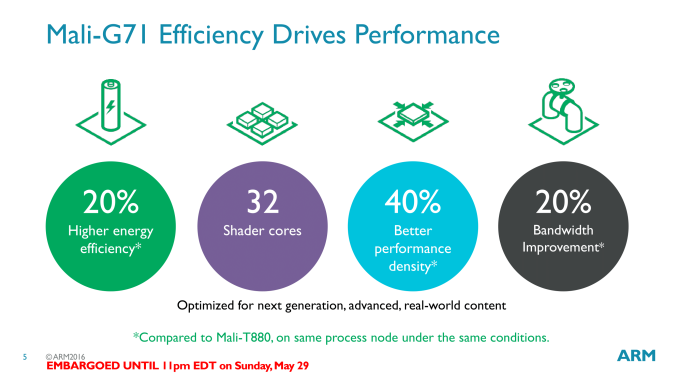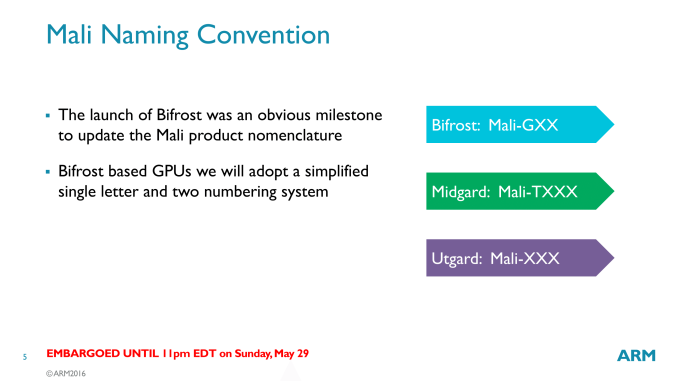ARM Unveils Next Generation Bifrost GPU Architecture & Mali-G71: The New High-End Mali
by Ryan Smith on May 30, 2016 7:00 AM ESTWrapping Things Up: Mali-G71, Coming Soon
Like ARM’s associated Cortex-A73 announcement, today’s Mali-G71 revelations are being made ahead of actual silicon availability. To that end a lot of ARM’s projections are based on early prototyping of manufacturing process and architectural simulations, though at this late stage those simulations tend to be pretty close.
ARM’s official numbers for G71 call for it to offer significant improvements over a same-process Mali-T880 with respect to both energy efficiency and density. For the former ARM is expecting G71 to deliver 20% better energy efficiency over T880, and on the latter to offer 40% better performance density – or in other words, the same performance at 40% less die space. Though ARM has not been heavily penalized for area efficiency, the latter has been one of the few areas where they haven’t done quite as well, and is something competitor Qualcomm is keen to call them out on.
From a performance standpoint, ARM is expecting G71-based devices to offer around 1.5x the performance of current, T880 devices. This is a slightly fuzzier metric – it’s not 50% faster at the same MP configuration – but rather a combination of manufacturing improvements, a larger number of shader cores, and Bifrost architectural improvements. Andrei also suspects that if we were looking at apples-to-apples ISO-power/ISO-area numbers where everything was held equal, the actual performance gains would be even greater.
With all of that said, expect to see G71 operate a lot like a drop-in replacement for current Mali GPUs when it comes to graphics. Bifrost is an architectural update for Mali rather than a feature update. There are no major graphics features that G71 supports that T880 does not; both deliver on the same OpenGL ES and Vulkan graphics functionality. The heterogeneous compute functionality on the other hand stands to make a big impact for general compute tasks, just not for graphics.
Ultimately what this gets ARM is a chance to recalibrate their architecture for the future, to better align with both what software developers are writing and what device manufacturers need in their GPUs. Bifrost is the new modern Mali, and the shift to a TLP-centric design should serve ARM well in the future based on what we’ve seen similar shifts do for AMD and others. Meanwhile the overall performance gains will allow ARM and its customers to hedge their bets on things such as 4K phones and mobile VR, giving them a more suitable GPU design to use if those innovations prove popular.
Wrapping things up, while ARM is only announcing the Mali-G71 today, the company has clearly left the door open to future GPU designs. As a high-end GPU design, G71 is the immediate successor to the T880, but I expect in time that ARM will want to produce GPU designs suitable to replace Mali T820 and the like. That ARM started at G71 is a good hint of what’s to come; future Bifrost GPUs will use the two digit G numbering scheme, so you can easily see where future GPUs may slot in.













57 Comments
View All Comments
mdriftmeyer - Tuesday, May 31, 2016 - link
Aren't you glad you commented yesterday? See the update to HSA.prisonerX - Wednesday, June 1, 2016 - link
You're confusing OpenCL C with OpenCL. SPIR-V is an intermediate language also supported by OpenCL.pencea - Monday, May 30, 2016 - link
How about the review for the GTX 1080? It's been days since the card came out. Other major sites have already posted their reviews on both the 1080 and 1070, while AnandTech still haven't posted one yet. Only a pathetic preview.Quake - Monday, May 30, 2016 - link
Quantiy over quality my friend. Anandtech is known to write some concise, detailed and thorough articles. For me, sites like Engadget are tabloid newspapers while Anandtech is a respected newspaper that takes it time to write some thorough and intelligent reviews.Tabalan - Monday, May 30, 2016 - link
True, but they could split review into 2 parts - 1st one would consists of tests, benchmarks, etc (like other websites do), other would be about uarchi on it's own. This way almost everyone would be happy.funkforce - Monday, May 30, 2016 - link
Engadget?! Come on! PCWorld, PCGamesHardware, HardOCP, KitGuru, Hothardware, Tomshardware, TechSpot, HardwareCanucks, TweakTown all posted their review, many almost as thourough as Anandtech... 13 days ago! And we could forgive Mr Smith if it was a one time thing, but it's been like this every GPU review since he took over as Editor in Chief.When Anand was in charge, no review was late like this and it still was as thorough.
Now I LOVE Ryan's writing, it's the best bar none, he is and awesome guy for sure!
But please! For the love of GOD, step down as Editor and focus on writing only, delivering on time without a boss to push you is not your thing...
Just check earlier reviews, same thing, 1-2 weeks late, even though promised so many times it would come out a week or two before actually published. (Except GTX 960 which never got published at all after 7 weeks of promises and then just silence)
Alexa shows this website has lost an insane amount of readers in 1 year. I have been here for almost 20 years and I just want AT to be great again. Please someone do something! Anyone?! <3 Please save AT!
r3loaded - Tuesday, May 31, 2016 - link
Because while other sites will be satisfied with a review that covers "zomg runs Crysis 3 and GTA V on max settings at xyz FPS, temps and noise are pretty good", Anandtech doesn't really roll that way. They won't be satisfied with their review until they've completed a deep dive on the Pascal architecture, the merits of GDDR5X and how it compares with GDDR5 and HBM/HBM2, and quantifying frame latency and consistency.Other reviews are written by gamers and computer enthusiasts. Anandtech reviews are written by computer engineers.
prisonerX - Tuesday, May 31, 2016 - link
1080 whiners like you are really tedious. I hope they cancel the review.jjj - Monday, May 30, 2016 - link
Any clue about cache sizes and if a reduction there is factored into the perf density math? Also wondering about thermal , some of the mentioned changes will help but some more details would be nice.allanmac - Monday, May 30, 2016 - link
Nice review. Delivering a full-featured Vulkan/SPIR-V 1.1 GPU to the masses is something we're all ready for.